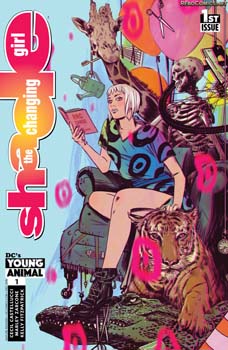Despite the moniker and the titles DC launched for Young Animal, Vertigo remains so I’m guessing DC is trying to be more granular with its audience. What surprised me was the writer for two of the four titles rolled out under this line, Gerard Way, the lead singer of My Chemical Romance. Since he is writing Doom Patrol with Grant Morrison’s blessing I had to see if he could emulate the odd book most loved in the early Nineties.

Doom Patrol returns to its weird and absurd days initiated by Morrison, ignoring all three of the boring reboots DC tried since 2001. Way is currently picking up the pieces from Morrison and Pollack’s run with a couple new characters: ambulance driver Casey Brinke and singing telegram deliverer/odd jobs doer Terry None. The Chief keeps making one-page cameos to remind the readers he’s still around. Favorites Cliff “Robotman” Steele and Larry Trainor the Negative Man are back along with Danny the Street and Flex Mentallo. Crazy Jane finally appeared in the fifth issue, I suspect she’ll either be a new enemy or the team will have to convince her to rejoin.
Sadly, the comic has been behind schedule and if Way’s hands are tied as I fear, he has one more issue to bring the current arc to a satisfactory close; DC and Marvel are now obsessed with six-issue story arcs in order to re-bundle back issues into trade paperbacks. Putting this minor complaint aside, I am enjoying the mystery involving Casey’s true origin while she tries to save Danny the Street’s residents from being ground up into cheap alien hamburgers. Cliff and Larry are assisting but they’re pretty confused.
Doom Patrol (volume six according to Wikipedia) is a book I highly recommend for those who want to read something different in the superhero genre. I continue to enjoy the usual fare of “long-underwear” titles yet it’s always fun to see someone turn the genre 90 degrees without it becoming too post modern, aka weird for the sake of being weird as the term is defined by Dana Gould.
As an extra treat, Brandon Bird has been providing his trademark coloring-book parodies in the comic’s back pages. You’ll have to see them because I don’t want to spoil the joke.

Shade the Changing Girl follows in the footsteps of Peter Milligan’s reinterpretation in the Nineties when Shade the Changing Man left Suicide Squad and helped expand the Vertigo line. The twist is this Metan (Shade’s race or nationality) is a young woman who uses the Madness Vest to possess the body of a teenage girl in a coma, not a death-row inmate. At first, Loma Shade (no relation to Rac Shade, the original poet/hero) is puzzled by the reactions she receives in her human form of Megan. Loma quickly learns that Megan was the captain of her synchronized swimming team and a horrible bully. Her teammates want to get revenge, the unpopular Teacup who Megan used to torment the most is frightened by Shade’s offer of friendship and her parents are the most befuddled in how the time in a coma altered her. For example, “Megan” is obsessed with older technologies such as vinyl and black and white television.
Meanwhile, back on Meta, Loma’s boyfriend Lepuck tries to protect her body (the M-Vest works in the same manner as Astral projection) from the authorities but eventually he’s captured and tortured by Director Loran. Loran uses the public safety as an excuse but she’s really obsessed with the Madness Vest because she used to be romantically involved with Rac Shade. Through Lepuck and Loma, Loran plans to harness the madness for her own purposes.
Shade‘s first story arc has concluded with Loma gaining full control of Megan’s body by banishing Megan’s “soul” and convincing her new friends Teacup and River that she really is a friendly alien.
Young Animal’s other two titles Cave Carson and Mother Panic didn’t interest me. I’m enjoying this pair probably due to familiarity with their earlier incarnations from when I was finishing university.
